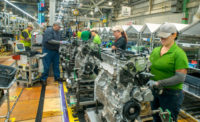BUFFALO, WV—Toyota’s engine and transmission assembly plant here will soon be the site of the largest solar panel array in the state.
To be completed by March 2021, the $4.9 million solar project will reduce CO2 emissions at the plant by 1,822 metric tons annually, according to Jacob Plasters, senior engineering manager Toyota Motor Manufacturing West Virginia. “The array will span 6 acres and generate 2.6 megawatts of solar-generated energy,” he says. “This is part of the company’s strategic goals to reduce its reliance on outside energy needed for operations.”
Established in 1996, the plant assembles nearly 1 million engines and transmissions for the Toyota Avalon, Camry, Corolla, Highlander, RAV4 and Lexus ES and RX350. In June, the plant became the first Toyota facility in North America to begin producing hybrid transaxles, which are built for the Highlander and Sienna.
The solar project is one of several initiatives by the plant to become more green. Other initiatives include smart building technologies that will allow the plant to control and optimize lighting, HVAC and other systems used in the facility.
The automaker is also planning solar projects at its assembly plants in Alabama and Missouri. In Alabama, the company’s Huntsville engine plant will have a 3.3-acre solar array that will generate 1.6 megawatts of solar-generated energy and reduce the plant’s CO2 emissions by 1,732 metric tons annually. That project is expected to be complete by December. In Missouri, the company’s assembly plant in Troy will will have a 1.5-acre solar panel array that will generate 0.75 megawatt of energy and reduce CO2 emissions 750 metric tons annually. That project is expected to be complete in January 2021.
Toyota is one of the top 20 corporate users of onsite solar energy in the U.S., according to the Solar Energy Industries Association.





